We need your consent to use the individual data so that you can see information about your interests, among other things. Click "OK" to give your consent.
ASTM D1293-12
Standard Test Methods for pH of Water
STANDARD published on 1.1.2012
The information about the standard:
Designation standards: ASTM D1293-12
Note: WITHDRAWN
Publication date standards: 1.1.2012
SKU: NS-16896
The number of pages: 10
Approximate weight : 30 g (0.07 lbs)
Country: American technical standard
Category: Technical standards ASTM
The category - similar standards:
Annotation of standard text ASTM D1293-12 :
Keywords:
hydrogen ion concentration, pH, pH buffer solution, Routine measurement (of pH) method, Water quality monitoring, Acidity, alkalinity, pH--water, Buffer solutions, Continuous measurement/monitoring, Field testing--water, Glass electrodes, Hydrogen ion concentration, Instrumental measurement--water, pH--glass electrode, pH--water, Precise laboratory measurement (of pH) method, Process pH measurements, Reference buffer solutions, Remote pH measurements
Additional information
| Significance and Use | ||||||||||||||||||||||
|
The pH of water is a critical parameter affecting the solubility of trace minerals, the ability of the water to form scale or to cause metallic corrosion, and the suitability of the water to sustain living organisms. It is a defined scale, based on a system of buffer solutions with assigned values. In pure water at 25°C, pH 7.0 is the neutral point, but this varies with temperature and the ionic strength of the sample. Pure water in equilibrium with air has a pH of about 5.5, and most natural uncontaminated waters range between pH 6 and pH 9. |
||||||||||||||||||||||
| 1. Scope | ||||||||||||||||||||||
|
1.1 These test methods cover the determination of pH by electrometric measurement using the glass electrode as the sensor. Two test methods are given as follows:
1.2 Test Method A covers the precise measurement of pH in water utilizing at least two of seven standard reference buffer solutions for instrument standardization. 1.3 Test Method B covers the routine measurement of pH in water and is especially useful for continuous monitoring. Two buffers are used to standardize the instrument under controlled parameters, but the conditions are somewhat less restrictive than those in Test Method A. For on-line measurement, also see Test Method D6569 which provides more detail. 1.4 Both test methods are based on the pH scale established by NIST (formerly NBS) Standard Reference Materials. 1.5 Neither test method is considered to be adequate for measurement of pH in water whose conductivity is less than about 5 μS/cm. Refer to Test Methods D5128 and D5464. 1.6 Precision and bias data were obtained using buffer solutions only. It is the user's responsibility to assure the validity of these test methods for untested types of water. 1.7 The values stated in SI units are to be regarded as standard. No other units of measurement are included in this standard. 1.8 This standard does not purport to address all of the safety concerns, if any, associated with its use. It is the responsibility of the user of this standard to establish appropriate safety and health practices and determine the applicability of regulatory limitations prior to use. |
||||||||||||||||||||||
| 2. Referenced Documents | ||||||||||||||||||||||
|
Similar standards:
Historical
1.5.2011
Historical
1.10.2008
Historical
15.5.2009
Historical
1.6.2012
Historical
1.9.2012
Historical
15.11.2008
We recommend:
Technical standards updating
Do you want to make sure you use only the valid technical standards?
We can offer you a solution which will provide you a monthly overview concerning the updating of standards which you use.
Would you like to know more? Look at this page.


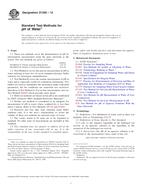
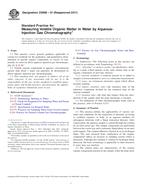 ASTM D2908-91(2011)..
ASTM D2908-91(2011)..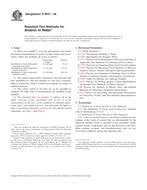 ASTM D2972-08
ASTM D2972-08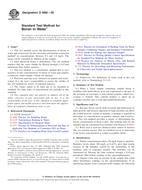 ASTM D3082-09
ASTM D3082-09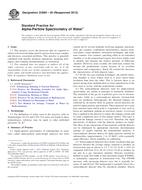 ASTM D3084-05(2012)..
ASTM D3084-05(2012)..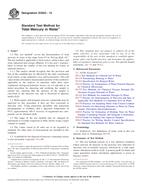 ASTM D3223-12
ASTM D3223-12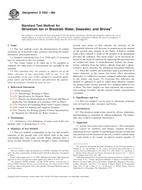 ASTM D3352-08a
ASTM D3352-08a
 Cookies
Cookies
